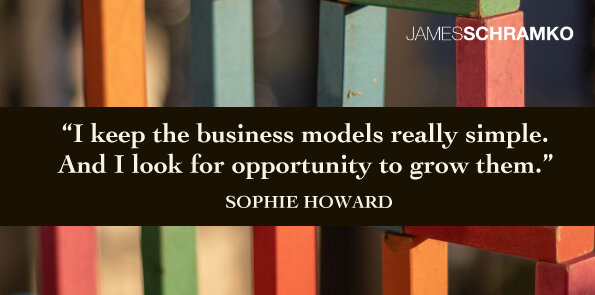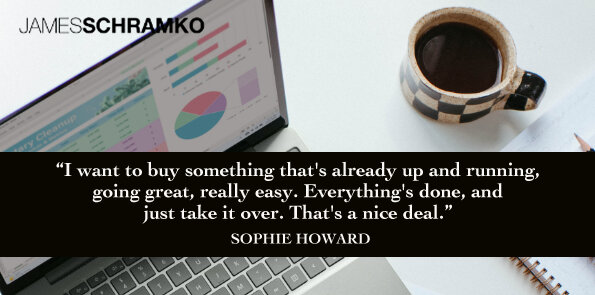Podcast: Download (Duration: 42:56 — 40.1MB)
Get Notified Of Future Episodes Apple Podcasts | Spotify | Amazon Music | Android | Blubrry | Gaana | TuneIn | Deezer | Anghami | RSS | More
In Sophie Howard’s first appearance on the show, she and James will be looking at the considerations of buying a business vs starting one.
With a portfolio of 30 businesses to her name, Sophie is well-qualified to contribute her expertise to the topic.
Among other things, Sophie and James will discuss: is buying an existing business a good idea?
They’ll talk about levels of involvement: whether one will be active in management or operations, or be a totally hands off investor.
And they’ll explore important questions to ask when buying a small business.
Table of contents
1. A familiar online presence?
2. A constantly growing portfolio
3. The typical reasons people sell good businesses
4. The skills you’ll need to have
5. What are the cash requirements?
6. Hands-on versus total investor
7. Has anything ever gone wrong?
8. Building on your passion
9. The stuff that’s working
10. Navigating the big platforms
11. Diversification and protecting the downside
12. Any thoughts of retiring?
13. If you want to do what Sophie does…
14. Before you do your first deal…
A familiar online presence?
A lot of people may recognize Sophie from her online presence. James knows she’s been involved with numerous promotions and partnerships, particularly relating to teaching business models.
It was about 10 years ago, says Sophie, that she began selling on Amazon, finding she excelled at product selection and brand building.
After selling one of her brands, she teamed up with a partner who transformed her small community into an extensive, high-quality training program. Together, they’ve ventured from Amazon FBA to Kindle publishing, with Sophie currently publishing approximately one book weekly.
Sophie has also mentored many students in this domain, and the partnership has thrived for nearly eight years.
A constantly growing portfolio
It’s become a running joke for James to ask Sophie what businesses she’s bought lately, referring to her constantly growing portfolio. Rather than starting businesses from scratch, Sophie largely purchases existing businesses to grow and optimize them. James asks if this approach is her current preference.
It is, says Sophie. During the lockdown, she observed fiction book publishers significantly outselling nonfiction authors. Intrigued by their methods but unfamiliar with the fiction business, Sophie decided to buy a fiction business from Empire Flippers. This business, which she purchased to understand the fiction market better, came with a well-organized team and proven marketing strategies.
The acquired fiction business proved valuable not just in terms of cash flow, but it also equipped Sophie with a ready-made business model and a team already familiar with the operations. The investment turned out quite beneficial, with the team continuing to work for her and the business consistently generating income.
Driven by the success of this venture, Sophie purchased a newsletter business, which has since provided a steady profit. It requires minimal effort on her part, with the operations mainly handled by an employee. The initial investment in this business was recouped within two years.
Encouraged by these successful acquisitions, Sophie has ventured into various business models, totaling about 30 acquisitions so far.
The typical reasons people sell good businesses
James asks Sophie the common reasons individuals sell businesses that still generate a good cash flow.
Sophie compares it to reasons people might sell cars or homes, suggesting that business owners often sell because they are moving toward a new venture and require a capital injection. She gives an example of a businessman she recently bought from, who sold his subscription business at a lower price to gather funds for a new cycling-related venture he was passionate about.
James notes that sellers have varied motivations, including changes in partnerships, boredom, the need for capital for another project, or reaching the end of their business tenure. He’s had his own experiences buying and selling businesses and domains. In one instance, he was able to sell a single domain for the price he paid for a bundle of 200 websites.
The skills you’ll need to have
What are the necessary skills, James asks, for purchasing and maintaining online businesses, especially for those with limited online experience or capital?
Sophie emphasizes the importance of understanding the purchased business model, ensuring its simplicity, and avoiding entanglements in complex tech. She underscores the value of keeping operations straightforward, seeking opportunities to expand the business (like replicating a UK-based website for the US market), and ensuring that the skill sets of the team can be easily replicated or hired if needed.
Sophie highlights that while she is not tech-savvy, she focuses on acquiring functioning businesses and retaining their original teams. In instances where technical assistance is required, she relies on her local team, which has more expertise. She stresses that one doesn’t necessarily have to be tech-proficient, but might require technical help for certain businesses, while others ventures, such as newsletter-based businesses, might not demand much tech knowledge at all.
What are the cash requirements?
Sophie speaks on the financial aspect of purchasing online businesses. Due to increased demand for online work-from-home businesses during COVID, Sophie was in a solid cash position, allowing her to buy various online businesses, including smaller WordPress sites.
With smaller sites, while the initial return might be minimal, the potential for growth is there. Investing in quality content and SEO optimization becomes crucial for growth, with the objective being increased Google traffic to drive revenue through ads and affiliate links.
Content writing has evolved due to AI tools, Sophie observes, leading to a split among content teams. Some prefer to use human-only content, while others integrate AI into their process. Unfortunately, this shift led to the downfall of some content agencies.
Despite not being involved in the technical or writing aspects herself, Sophie emphasizes the need for consistent content generation to boost traffic and, consequently, revenue.
Regarding payment methods for online businesses, some vendors offer partial financing options. Neutral third parties, such as escrow services, handle the payments to ensure secure and fair transactions. However, vendor financing can become complicated as domains might not be released until final payments, potentially hindering immediate modifications to the purchased site.
Sophie suggests that cash deals are often cleaner and can lead to better negotiations on price.
The standard asking price for online businesses is about three times their annual net profit. This rate provides an impressive return on investment. However, data reveals that actual closed deal prices can be significantly lower than the asking price, especially if one is prepared to pay in cash. Therefore, purchasing online businesses can offer a quick payback period and, if nurtured correctly, a consistent profit stream, allowing for a relatively passive income approach.
Hands-on versus total investor
Sophie emphasizes the value of outsourcing technical and writing tasks, given that skilled professionals are often more proficient and cost-effective than attempting to handle everything oneself. This approach allows for managing a diverse portfolio without being overwhelmed by hands-on responsibilities.
James notes that while there are individuals who tackle everything themselves and others who invest without any tech knowledge, both approaches have inherent weaknesses. An ideal approach would strike a balance between these two extremes, with the investor having sufficient knowledge to make informed decisions while also leveraging external expertise.
James reflects on his own experience, how he initially tried to learn and manage everything himself, a path that proved time-consuming. He also mentions, however, the potential pitfalls for investors who lack technical knowledge, as they might be easily deceived or unable to effectively manage and oversee their investments. This underscores the advantage of having a mix of investment insight and a basic understanding of the technical side.
Has anything ever gone wrong?
Has Sophie ever had ventures not go according to plan? Not having faced any major disasters, Sophie emphasizes the importance of due diligence and her strategy for avoiding pitfalls. She avoids purchasing Amazon FBA businesses and Shopify sites for physical goods due to the gaps in data flows and potential hidden issues. Instead, Sophie focuses on online businesses that have been operational for at least a year, to gauge their performance through various market conditions.
Sophie shares insights into one of her successful acquisitions: a website about playing the guitar. Although she lacks personal expertise in music, she has hired professionals to develop content and grow the site. By leveraging her expertise in publishing, she has expanded the website’s offerings to include educational content, books, and even potential subscription services.
However, Sophie also realizes the challenges of investing in fields outside her personal interests. Despite the guitar website’s success, her lack of enthusiasm for the subject matter made it difficult to innovate and ensure quality. She emphasizes the importance of investing in areas she’s passionate about, as it allows her to identify growth opportunities more effectively.
Sophie has since made a more significant acquisition in online education, an area she is personally invested in. She highlights the advantage of her diverse portfolio, noting how it insulates her from risks associated with having a single income stream.
Both Sophie and James agree on the benefits of diversification. James underscores the importance of engaging in a global marketplace, while Sophie acknowledges the financial advantages of earning in stronger currencies while living in a location with a weaker currency, giving her an edge in her investments.
Building on your passion
James discusses the importance of authenticity and passion in content creation, drawing from his personal experience with his surfing site. Having first-hand experience with the boards he reviews lends credibility to his content, which resonates with his audience and even garners appreciation from board shapers. This authentic touch makes his content stand out amid the plethora of generic, AI-generated reviews flooding the internet.
Sophie concurs with James on the significance of genuine content in today’s digital landscape. With the increasing volume of inauthentic, automated content, real people sharing genuine opinions and experiences will continue to be valued and recognized. She also speaks of the importance of using diverse content types, such as video, to enhance user engagement.
The stuff that’s working
James and Sophie discuss their preferred marketing strategies, with Sophie emphasizing the power of email lists and SEO. She particularly values newsletters, mentioning what is probably her best deal, a newsletter that makes 90K a year and paid for itself in under 24 months.
Sophie also focuses on keeping her WordPress sites updated with quality articles on subjects she is genuinely interested in. While she incorporates YouTube as an auxiliary channel, she avoids platforms like Facebook ads and TikTok.
James touches on the topic of personal strengths and how they align with marketing methods. Sophie acknowledges that while her strengths lie in email marketing and SEO, there are plenty of untapped opportunities in social media for those who excel in that realm. If someone possesses strong social media skills combined with a commercial mindset, they can potentially buy and monetize numerous idle assets.
Navigating the big platforms
Sophie mentions she has purchased Facebook communities and email lists directly from their owners, especially when these individuals are looking for a financial boost. While James knows many social platforms frown upon or prohibit the sale of user positions or accounts, he acknowledges the practice is not uncommon.
James cites the example of sponsoring the description box of a YouTube channel by placing one’s link in it.
Sophie adds that though Amazon claims not to allow the sale of accounts, she has sold a high-value Amazon account. She references Thrasio, a company that raised significant funds to acquire and consolidate various Amazon accounts. There’s a disparity between platform guidelines and real-world practices.
James emphasizes the risks involved in heavily relying on large platforms for income. These platforms frequently undergo changes that might not benefit all users. He cites Twitter’s evolution as an example, suggesting that over-dependence on a platform can leave one vulnerable to the whims of powerful stakeholders.
Diversification and protecting the downside
Sophie stresses the importance of protecting one’s investments by mitigating downside risks, taking cues from investors like Warren Buffett and Ray Dalio. She believes in diversifying her online businesses across various platforms and channels, such as WordPress, newsletters, and YouTube, ensuring that a glitch or problem in one doesn’t affect the others. This diversification strategy offers resilience and stability in her portfolio.
With a significant number of businesses in her portfolio, Sophie notes the benefits of economies of scale. This scale provides enhanced purchasing power, allowing her to negotiate better deals with service providers, like hosting platforms or content agencies. Moreover, having everything hosted on a single platform like Kinsta and using consistent themes and plugins across her websites brings efficiency.
Sophie credits her Chief Operating Officer in New Zealand, who’s adept at systems thinking and technical aspects, for streamlining processes and ensuring everything is organized, reducing the chances of mishaps.
James points out that apart from managing her portfolio, Sophie is also passionate about educating others. Drawing from her vast experience and knowledge, she teaches people how to invest in and manage online businesses. Her enthusiasm and success in this field are evident, and James commends her for both her achievements and her drive to share her expertise with others.
Any thoughts of retiring?
Explaining Sophie’s multifaceted career to her family is a challenge. Coming from an entrepreneurial background, her family members have traditionally retired by 40, which makes her unique for still being active in her ventures beyond that age.
Sophie acknowledges she’s different from her predecessors, and doesn’t see retirement on the horizon.
James has seen Sophie’s relentless activity and engagement in his Mentor program, and admires her passion and energy. Sophie admits that while she has a penchant for creativity, she quickly loses interest in tasks that are more routine or structured. However, one consistent interest she maintains is learning. She’s always eager to absorb new knowledge, whether through programs, books, or podcasts, covering a wide range of topics from business to philosophy.
Sophie’s insatiable thirst for knowledge recently led her to undertake a course on artificial intelligence at MIT. While she recognizes that competing with larger platforms in AI isn’t feasible for her, the knowledge she gained has helped her spot potential challenges and update her strategies.
This constant learning ensures that Sophie remains updated and equipped to deal with the ever-evolving digital landscape.
If you want to do what Sophie does…
Sophie has established a website named aspiringentrepreneurs.com, where she offers training on how to invest in online businesses. The course assumes that participants are not tech-savvy and do not have substantial funds for investing. Instead, it teaches them to outsource daily operations, and doesn’t require the financial background typical of Wall Street financiers.
In the realm of buying online businesses, Sophie and James emphasize the importance of strategy over technical skills. James believes individuals shouldn’t get bogged down with learning how to code or build websites, since the market for these skills is oversaturated and commoditized. Sophie agrees, noting that it’s more effective to hire professionals for tech-related tasks.
Sophie’s teaching approach centers on starting small, focusing on strategy, and viewing the process as an alternative investment. The returns, she says, can surpass traditional investment routes like property or stocks. While there’s inherent risk, the opportunity for reward is high, especially given the greater number of businesses for sale compared to serious buyers. This imbalance means that those who approach sellers with a clear and serious intent often find themselves securing good deals quickly.
Sophie’s teachings emphasize building rapport and negotiation skills over purely technical aspects. Sophie believes in purchasing well-established, thriving businesses rather than starting from scratch or reviving failed ventures. She focuses on ensuring a smooth transition with the seller, maintaining a positive relationship, and inheriting a business that’s easy to manage and profitable from the outset.
Before you do your first deal…
For those embarking on their first business deal, Sophie advises a cautious and detailed approach, stressing the importance of thorough assessment and due diligence. She urges would-be business buyers to envision growth opportunities, such as expanding platforms or introducing new product links. Platforms like Flippa offer vetted listings and reduce risks through rigorous checks of business analytics.
Sophie recommends a portfolio approach for purchasing businesses. By owning a diverse set of businesses, entrepreneurs can ensure a stable income stream without excessive risks associated with over-investing in a single, large business. She emphasizes the value of long-term thinking and continuous learning, particularly about enhancing customer experiences and staying updated with major platform changes.
James praises Sophie’s strategic approach. Her philosophy of knowing one’s comfort level in business resonates with him. He observes that businesses of certain sizes come with significant challenges and stresses, which might not align with every entrepreneur’s goals or values. He has maintained his own business at a level that ensures reward without excessive strain.
Sophie’s platform, AspiringEntrepreneurs.com, offers free training and resources for those interested in her approach. She notes that while buying a business might not be the first step for many, it can be an expedited way to own a successful, profitable business, for those with some prior entrepreneurial experience or background.
Looking to build your own business portfolio? Check out Sophie’s training
Enjoyed the show? Leave us a review on iTunes













Leave a Reply